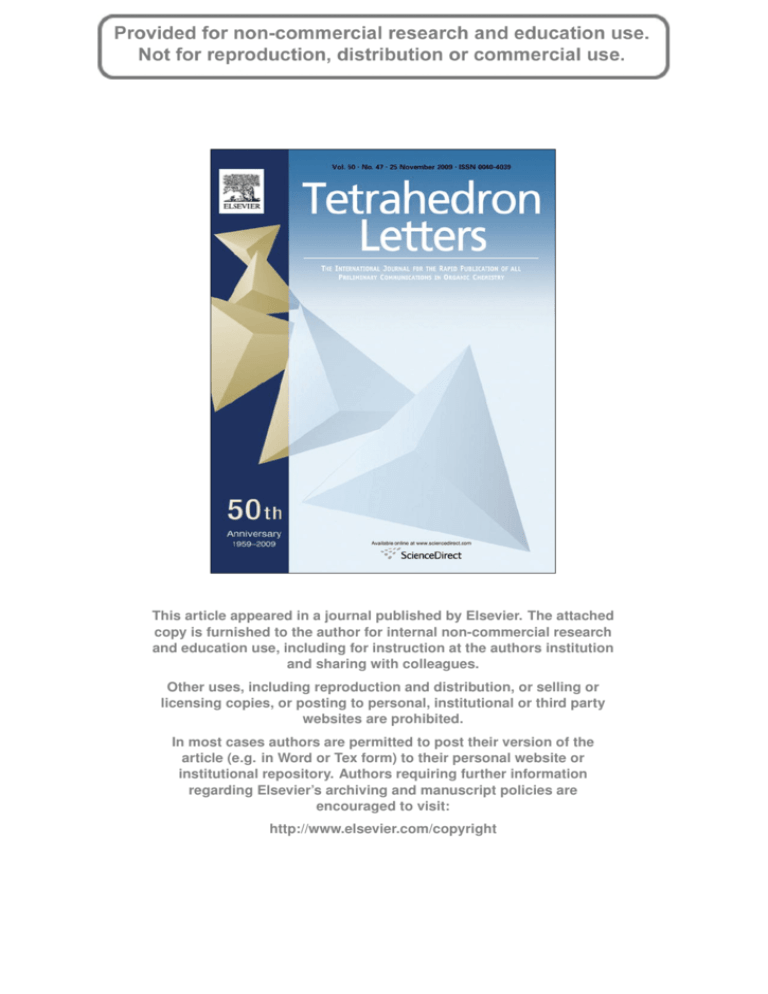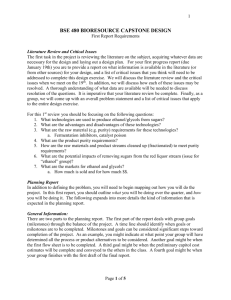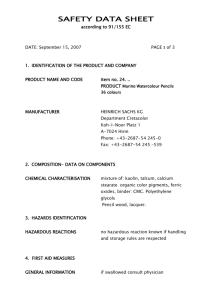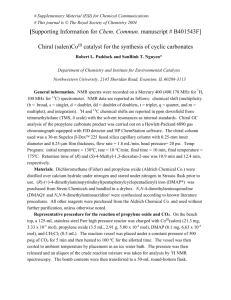
This article appeared in a journal published by Elsevier. The attached
copy is furnished to the author for internal non-commercial research
and education use, including for instruction at the authors institution
and sharing with colleagues.
Other uses, including reproduction and distribution, or selling or
licensing copies, or posting to personal, institutional or third party
websites are prohibited.
In most cases authors are permitted to post their version of the
article (e.g. in Word or Tex form) to their personal website or
institutional repository. Authors requiring further information
regarding Elsevier’s archiving and manuscript policies are
encouraged to visit:
http://www.elsevier.com/copyright
Author's personal copy
Tetrahedron Letters 50 (2009) 6469–6471
Contents lists available at ScienceDirect
Tetrahedron Letters
journal homepage: www.elsevier.com/locate/tetlet
Convenient multigram synthesis of monodisperse oligo(ethylene glycols):
effective reaction monitoring by infrared spectroscopy using an attenuated
total reflection fibre optic probe q
Daniel Lumpi a, Christian Braunshier a,*, Christian Hametner a, Ernst Horkel a, Bernhard Zachhuber b,
Bernhard Lendl b, Johannes Fröhlich a
a
b
Institute of Applied Synthetic Chemistry, Vienna University of Technology, 1060 Vienna, Austria
Institute of Chemical Technologies and Analytics, Vienna University of Technology, 1060 Vienna, Austria
a r t i c l e
i n f o
Article history:
Received 16 July 2009
Revised 28 August 2009
Accepted 1 September 2009
Available online 6 September 2009
Keywords:
Monodisperse OEG PEG
Trityl cleavage
Oligo(ethylene glycols)
In situ reaction monitoring
ATR-IR-sensor spectroscopy
a b s t r a c t
A convenient approach for the synthesis of monodisperse oligo(ethylene glycols) up to 12 units is
described. A novel cleavage protocol replacing laborious hydrogenolysis is introduced to achieve a fast,
inexpensive and widely applicable procedure. In addition to the synthetic part, Fourier transform infrared
(FTIR) spectroscopy using a fibre optic attenuated total reflection (ATR) sensor was applied to monitor the
formation of sensitive key intermediates, resulting in optimized reaction times. By applying this in-line
technique, the possibility of real-time analysis under inert conditions was impressively demonstrated.
Ó 2009 Elsevier Ltd. All rights reserved.
Oligomers of ethylene glycol (PEGs) have a wide range of applications in many fields of science and industry. They can be applied
as synthons for crown ether-type derivatives,1 non-ionic surfactants,2 templates for the synthesis of porous inorganic materials,3
and more recently, functional mono-layers were used to develop
biocompatible material.4 In the field of biomedical engineering
‘hydrogels’ prevent unspecific adsorption of proteins from biological media. Another application field is bioconjugation of proteins,
in order to increase the water solubility, which serves as one of
the most effective drug delivery systems.5 As a matter of fact, the
physical and chemical properties of these modified materials often
depend significantly on the number of repetition units of the PEG
tether.
As part of our ongoing research on PEG-grafted polystyrene resins,6 a series of novel polystyrene-oligo(oxyethylene) graft copolymers containing monodisperse PEG units (n = 2–12, even numbers)
have been synthesized and examined regarding their applicability
for gel-phase 13C NMR spectroscopy.7 A stronger correlation than
expected between the graft length and the line widths in the gelphase spectra was observed. As a consequence, the demand arose
to synthesize monodisperse PEGs most efficiently.
q
Dedicated to Professor Peter Stanetty on the occasion of his 65th birthday.
* Corresponding author. Tel.: +43 650 4531979; fax: +43 1 58801 15499.
E-mail address: christian@braunshier.at (C. Braunshier).
0040-4039/$ - see front matter Ó 2009 Elsevier Ltd. All rights reserved.
doi:10.1016/j.tetlet.2009.09.010
For the preparation of the resins mentioned above, we required
access to well-defined oligo(ethylene glycols) of up to 12 units.6
Despite the widespread utility of PEGs, their synthesis remains a
challenging task. The published synthetic methods for commercially unavailable or expensive representatives (n >4) are usually
time-consuming or include extensive purification procedures.
To the best of our knowledge, the most promising approach was
published by Keegstra et al.,8 who applied bidirectional chain elongation. Taking this sequence as a starting point, we intended to
optimize the key steps in order to shorten reaction times from
periods as long as several days to more acceptable values. Eliminating this major disadvantage would result in an easy to handle,
fast and low-cost synthetic procedure for well-defined oligo(ethylene glycols).
The first reaction step shown in Scheme 1 (deprotonation of
mono-trityl protected glycols 1a–b) is reported to take at least
18 h to reach completion.
To verify this, it was necessary to monitor the conversion in an
inert, anhydrous reaction medium. Encouraged by recent studies,9
a mid-IR fibre optic probe was chosen for fast in-line monitoring of
the chemical reaction under investigation. The ATR fibre system
consisted of the FTIR spectrometer Bruker Matrix FÒ in connection
with an ATR fibre probe (A.R.T. Photonics, Berlin; Ø 12 mm) and a
MCT (mercury cadmium telluride) detector (Belov Technology, Co.,
Inc.). The probe was directly inserted through the ground neck of
Author's personal copy
6470
D. Lumpi et al. / Tetrahedron Letters 50 (2009) 6469–6471
Table 1
Reaction times and yields for the preparation of 3a–d
Scheme 1. Synthesis of glycols 3a–d; monitoring via ATR-IR-sensor spectroscopy.
the reaction vessel and comprised two 1 m silver halide fibres (Ø
1 mm) connecting to a conical two bounce diamond ATR element
housed in a rod of hastelloy. Using this set-up it was possible to follow the reactions to be studied in real-time covering a spectral
range from 600 to 2000 wavenumbers.
The major advantage of in-line versus at-line ATR-IR-spectroscopy is that monitoring takes place inside the reaction system, thus
eliminating steps such as workup of samples prior to analysis,
which avoids the risk of contamination or a loss of inertness. In
our work we focus on the deprotonation of the monoprotected glycols 1a–b. The progress of these reactions can either be determined
by tracking changes in absorbance values at selected wavenumbers
or applying modern chemometric methods, which process the entire spectral information. Among these multivariate curve resolution, alternating least squares (MCR-ALS) needs to be
mentioned.10 This technique decomposes the recorded data set
into smaller matrices containing information on the spectra and
the concentration profiles of each component involved in the reaction. A recently available user friendly interface for Matlab facilitates this type of data analysis.
Indeed, measurements indicated a rapid conversion of glycols
1a–b to the corresponding alkoxides. Absorbance values at characteristic wavenumbers for the substrate and the product, respectively, are plotted versus reaction time in Figure 1. The blue
curve derives from substance 1b, the green graph originates from
deprotonated 1b. Monitoring here did not employ the more complex MCR-algorithm, but just non-overlapped single band monitoring. The graph clearly shows that after 90 min no significant
changes of absorption values can be observed, thus being an indicator for the end of the reaction.
Figure 1. ATR-IR in-line monitoring for the deprotonation of monoprotected glycol
1b. Distortions for t 6 10 min are attributed to equilibration effects (temperature
and concentration).
In fact, we could prove that this step is completed after a reaction time of 90 min for glycol 1b and 210 min for 1a, respectively.
According to the original procedure, the subsequent nucleophilic reaction of the alkoxide with the tosylated glycols 2a–b
has to be performed at room temperature. Refluxing the reaction
mixture in THF as a solvent to increase conversion rates leads to
products, which were dark in colour and contaminated by inseparable impurities. However, optimization studies showed that performing the reaction at 40 °C shortens the time from 96 h to 58–
80 h avoiding the formation of unwanted by-products11 (Table 1).
a
b
Entry
Glycol
1
Tosylate
2
Timea
(h)
Product
3
Yieldb
(g)
Yieldb
(%)
1
2
3
4
1a
1a
1b
1b
2a
2b
2a
2b
4/84
4/84
2/60
2/60
3a
3b
3c
3d
18.8
165.4
23.2
24.6
98
97
98
95
Times given refer to deprotonation and overall reaction time, respectively.
Isolated yields.
To obtain the desired oligo(ethylene glycols) 4a–d, the protecting groups have to be cleaved off. Virtually all published procedures use hydrogenolysis under high-pressure conditions in the
presence of palladium for several days to achieve this final transformation (Scheme 2). Aside from long reaction time, this procedure suffers from some more disadvantages. The most serious
one is the need for equipment allowing to perform gas reactions
under high pressure, which might be a limiting factor. Furthermore, the reaction was never quantitative in our hands, always
leaving small amounts of protected glycols in the product. Finally
the use of halogenated organic solvents, for example, dichloromethane and transition metal catalysts might become troublesome, if the final product is intended to be used in the field of
pharmaceutics or biology, especially when the procedure is performed on industrial scale.
Scheme 2. Synthesis of glycols 4a–d; hydrogenolysis versus acidic cleavage.
Our approach was to substitute this deprotection step against a
safe, fast and inexpensive procedure. To the best of our knowledge,
the well known acidic cleavage of trityl groups was not reported
for this substance class until now. This is quite surprising, as we
could show that the usage of aqueous acetic acid leads to pure
products 4a–d in nearly quantitative yields avoiding any tedious
workup or implementation of chromatographic methods (Table
2).12 It is worth mentioning, that it is necessary to stick to the given
reaction conditions (time and temperature) to prevent the formation of the corresponding diacetates.13
Comparing this new protocol to hydrogenolysis, the advantages
are clearly visible: dramatically shortened reaction times (2 h vs
4 days), easier workup and higher product quality (purity determined by 1H NMR; compared to products synthesized in our lab
according to literature). Moreover, nearly the theoretical amount
of triphenylmethanol (pure according to combustion analysis) is
isolated during workup and can simply be transformed to tritylchloride14 enhancing the atom efficiency of the entire synthetic
route.
In summary, we have reported an optimized protocol for the
synthesis of monodisperse poly(ethylene glycols) up to 12 units.
In contrast to other approaches described in literature, neither special equipment for high pressure hydrogenolysis nor any chromatographic purification is needed for the key steps of the
sequence, making it attractive for especially large scale or industrial applications. In-line ATR-IR spectroscopy was shown to be a
powerful analytical tool for the effective monitoring of ‘problematic’ processes. Due to the non invasive nature, this promising
technology might arise as the solution for examining reactions
Author's personal copy
D. Lumpi et al. / Tetrahedron Letters 50 (2009) 6469–6471
Table 2
Yields for the preparation of 4a–d
a
Entry
Tritylate 3
Product 4
Yielda (g)
Yielda (%)
1
2
3
4
3a
3b
3c
3d
4a
4b
4c
4d
5.5
53.2
9.0
10.8
98
96
98
99
Isolated yields; reaction conditions: 80% AcOH, 40 °C, 2 h.
under inert conditions. The scope of possible applications is
widespread. In the field of organic chemistry one can imagine to
apply this technique to, for example, metalation reactions, deprotonations, catalytic reactions under inert atmosphere (transition
metal assisted coupling, olefin metathesis), etc. Experimental work
covering some of these projects is already in progress. Furthermore, the possibility of elucidation of reaction mechanisms by
monitoring transition states is clearly visible. This field of application is more sophisticated and will therefore be the aim of future
projects.
Acknowledgements
The authors want to thank A.R.T. Photonics for providing us
with the mid-IR fibre optic probes used in this work. The financial
support granted by the Austrian Science Fund within the project
L416-N17 is also acknowledged.
Supplementary data
Supplementary data (experimental details and compound characterization data of substances 3a–d and 4a–d, copies of spectra
(1H NMR, 13C NMR, IR)) associated with this article can be found,
in the online version, at doi:10.1016/j.tetlet.2009.09.010.
References and notes
1. Huszthy, P.; Bradshaw, J. S.; Zhu, C. Y.; Izatt, R. M.; Lifson, S. J. Org. Chem. 1991,
56, 3330–3336.
2. Chu, B.; Zhou, Z.. In Nonionic Surfactants: Polyoxyalkylene Block Copolymers,
Surface Sciences Series; Nace, V. M., Ed.; Marcel Dekker: New York, 1996; Vol.
60,.
3. Zhao, D.; Huo, Q.; Feng, J.; Chmelka, B. F.; Stucky, G. D. J. Am. Chem. Soc. 1998,
120, 6024–6036.
4. (a) Groll, J.; Amirgoulova, E. V.; Ameringer, T.; Heyes, C. D.; Roecker, C.; Nienhaus,
G. U.; Moeller, M. J. Am. Chem. Soc. 2004, 126, 4234–4239; (b) Li, L.; Chen, S.; Jiang,
S. J. Biomater. Sci., Polym. Ed. 2007, 18, 1415–1427; (c) Clare, T. L.; Clare, B. H.;
Nichols, B. M.; Abbott, N. L.; Hamers, R. J. Langmuir 2005, 21, 6344–6355.
6471
5. (a) Yamamoto, Y.; Yoshioka, H.; Takehana, T.; Yoshimura, S.; Kubo, K.;
Nakamoto, K. Polym. Prepr. (Am. Chem. Soc., Div. Polym. Chem.) 2009, 50, 161–
162; (b) Guiotto, A.; Canevari, M.; Pozzobon, M.; Moro, S.; Orsolini, P.;
Veronese, F. M. Bioorg. Med. Chem. 2004, 12, 5031–5037; (c) Lee, L. S.; Conover,
C.; Shi, C.; Whitlow, M.; Filpula, D. Bioconjugate Chem. 1999, 10, 973–
981.
6. Braunshier, C.; Hametner, C.; Froehlich, J.; Schnoeller, J.; Hutter, H. Tetrahedron
Lett. 2008, 49, 7103–7105.
7. Braunshier, C.; Hametner, C. QSAR Comb. Sci. 2007, 26, 908–918.
8. Keegstra, E. M. D.; Zwikker, J. W.; Roest, M. R.; Jenneskens, L. W. J. Org. Chem.
1992, 57, 6678–6680.
9. (a) Heise, H. M.; Kuepper, L.; Butvina, L. N. Anal. Bioanal. Chem. 2003, 375, 1116–
1123; (b) Bentrup, U.; Kuepper, L.; Budde, U.; Lovis, K.; Jaehnisch, K. Chem. Eng.
Technol. 2006, 29, 1216–1220; (c) Minnich, C. B.; Buskens, P.; Steffens, H. C.;
Baeuerlein, P. S.; Butvina, L. N.; Kuepper, L.; Leitner, W.; Liauw, M. A.; Greiner, L.
Org. Process Res. Dev. 2007, 11, 94–97.
10. Jaumot, J.; Gargallo, R.; de Juan, A.; Tauler, R. Chemometr. Intell. Lab. Syst. 2005,
76, 101–110.
11. Synthesis of 1,1,1,27,27,27-hexaphenyl-2,5,8,11,14,17, 20,23,26-nonaoxaheptacosane 3b. Under argon, a 4-neck round bottom flask equipped with
mechanical stirrer, reflux condenser, thermometer (and dropping funnel,
respectively) and the ATR-IR Probe inlet was charged with sodium hydride
(12.00 g, 500 mmol, 2.5 equiv) and dry THF (500 mL). To the well stirred
suspension was added a solution of mono-trityl protected glycol 1a (139.38 g,
400 mmol, 2.0 equiv) in dry THF (500 mL) at room temperature. After
completion of the reaction according to IR-monitoring (4 h), the mixture was
cooled to 0 °C and a solution of di-tosylated glycol 2b (100.52 g, 200 mmol,
1.0 equiv) in dry THF (500 mL) was added. The temperature was adjusted to
40 °C and the suspension was stirred for 80 h. For workup, the reaction mixture
was poured onto ice water (1200 mL)/chloroform (800 mL). The phases were
separated and the aqueous phase was extracted with chloroform (500 mL). The
combined organic layers were washed with brine (500 mL) and dried over
sodium sulfate. After removing the solvent under reduced pressure, the title
compound was obtained as a clear, slightly orange, viscous oil. Yield: 165.36 g
(97%). 1H NMR (200 MHz, DMSO-d6) d = 7.48–7.15 (m, 30 H), 3.67–3.39 (m, 28
H), 3.06 (t, J = 4.8 Hz, 4 H); 13C APT NMR (50 MHz, DMSO-d6) d = 143.8 (s),
128.2 (d), 127.8 (d), 126.9 (d), 85.9 (t), 70.1 (t), 69.9 (t), 69.85 (t), 69.82 (t),
69.77 (t), 69.7 (t), 63.0 (t). Anal. Calcd for C54H62O9 (855.09): C, 75.85; H, 7.31.
Found: C, 76.15; H, 7.15; N, <0.05.
12. Synthesis of 3,6,9,12,15,18,21-heptaoxatricosane-1,23-diol 4b. Compound 3b
(128.26 g, 150 mmol) was stirred with 80% acetic acid (1200 mL) at 40 °C. After
2 h the reaction was completed according to HPLC analysis. The mixture was
allowed to cool to room temperature and poured onto ice water (600 mL). The
precipitate was filtered off over a glass sinter funnel. The filtrate was
concentrated under reduced pressure leaving a cloudy oil. The crude product
was mixed with cold water (500 mL) and the suspension was again filtered
over the same glass sinter funnel, still containing the bed of triphenylmethanol
formed during the first filtration. The filter cake was washed with cold water,
giving 77.02 g (99%) of pure triphenylmethanol after drying at 40 °C/15 mbar.
The solvent of the filtrate was removed under reduced pressure (0.05 mbar) to
afford the title compound as a clear, slightly orange oil. Yield: 53.20 g (96%). 1H
NMR (200 MHz, CDCl3) d = 3.62–3.38 (m, 32 H), 3.30 (br s, 2 H). 13C NMR
(50 MHz, CDCl3) d = 72.2, 70.15, 70.10, 69.9, 61.1. Anal. Calcd for C16H34O9
(370.44): C, 51.88; H, 9.25. Found: C, 51.81; H, 9.34; N, <0.05.
13. Increasing reaction temperature from 40 °C to reflux and prolonging reaction
times from 2 h to 3 d results in almost a quantitative formation of the
corresponding diacetates. However, these can be converted into the desired
glycols by sodium methanolate-catalyzed transesterification.
14. Bachmann, W. E. Org. Synth. 1943, 23, 100.









